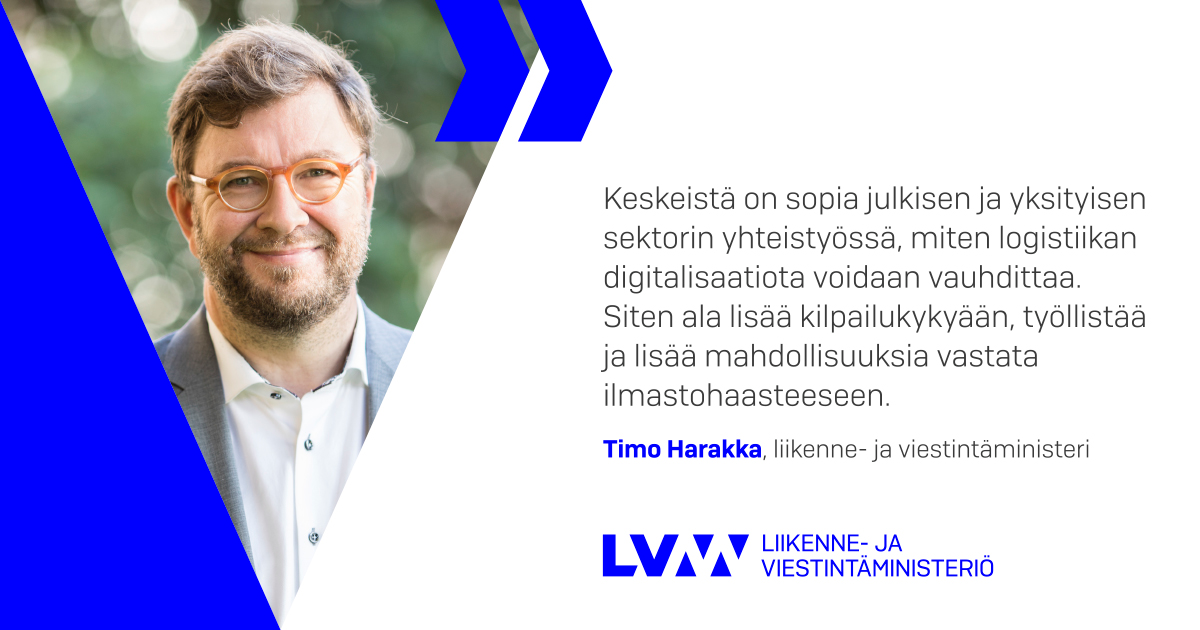Infrastructure, logistics and data included as a package in the Logistics Digitalisation Strategy

According to a new Logistics Digitalisation Strategy, use of real-time, digital data as well as common rules on how to utilise the data are needed in order to digitalise the logistics sector.The vision of the Strategy is that Finland will move towards efficient and sustainable logistics by means of digitalisation.
On 5 October 2020, the Ministry of Transport and Communications published the Logistics Digitalisation Strategy that defines a vision, goals and measures for the digitalisation development in the sector.
The purpose of the Strategy is to steer future policy measures in relation to the digitalisation of logistics and the operating environment in the logistics sector. The Strategy supports the objectives of both the twelve-year National Transport System Plan (Liikenne12) and fossil-free transport.
The vision of the Strategy is that with the help of digitalisation it is possible to provide more efficient and safer transport services whose climate impacts are more sustainable. In practice, this means that better use of data should be promoted and digital skills improved in the sector. Common rules should also be established to provide different operators with equal opportunities within both national and international frameworks.
Minister of Transport and Communications Timo Harakka says that a lot of work has already been done in Finland to prepare our operating environment for the digital development. Finland's path towards a leading country in digitalisation is facilitated by open cooperation and common understanding of the benefits generated by digitalisation to all parties involved. We are striving for global interoperability and that is why open cooperation and common guidelines at EU and international levels play an important role.
"It is essential to agree, in cooperation between the public and private sectors, on how to accelerate the digitalisation of logistics. That way the sector will increase its competitiveness, employment and opportunities to respond to the climate challenge," says Minister Harakka.
The development of the logistics sector is largely influenced by changes in society, trade and industry, such as the decentralisation of the regional structure and the growth of e-commerce. The importance of logistics has also been highlighted by the COVID-19 pandemic as people have taken digital services into use. It is expected that demand for digital platforms and customised services will continue to grow. That is why it is important that digital solutions and innovations in the sector can be scaled from international markets to Finland.
Management of real-time information at the core of logistics
A significant part of logistics development focuses on the management and utilisation of data throughout the supply chain as well as on real-time and automated access to information. The introduction of the benefits of digitalisation also calls for investments in the development of skills. There should be labour available in the sector that can utilise and develop digital solutions.
The Strategy includes six proposals for measures aiming at more efficient management of digital data: cooperation, enabling legislation, development of the logistics data environment, promotion of access to monitoring data and development of statistics. The Strategy also includes measures related to the funding of the operations, the equipment and capacity.
By using new operating models and technologies it is possible to create a more level playing field for the sector both in Finland and internationally. This also prevents grey economy.
Climate issues to be included in everyday logistics
The Strategy also aims to increase the opportunities for people and businesses to influence their carbon footprint through transport needs.
The efforts to combat climate change in the sector should primarily be dealt with by an agreement between companies, but also through legislation, if necessary. Achieving the emission reduction targets would require the real-time monitoring and emissions data of transport chains to be available in an internationally cohesive format.
The Digitalisation Strategy implements the goals set in the Government Programme for digitalised and carbon-free transport. To support the impact assessment of the Strategy, a climate study on the digitalisation of logistics was also carried out. It assessed the potential for reducing emissions through digitalisation in the sector and ways of influencing the reduction of emissions.
What are the next steps?
After the publication of the Logistics Digitalisation Strategy, the legislative needs and the need for a strategy implementation plan will be assessed. It will also be monitored that the objectives of the Strategy will be taken into account in future EU calls for project proposals.
Inquiries:
Maria Rautavirta, Director of Unit, tel. +358 40 718 5975, Twitter: @mrautavirta
Noora Lähde, Senior Specialist, tel. +358 45 222 2017, Twitter: @NooraLahde
Press release, 28 March 2018: Data utilisation and intelligent automation to boost the digitalisation of logistics
Government, publications: Logistiikan digitalisaatiostrategia: Kohti tehokasta ja kestävää logistiikkaa digitalisaatiolla (Logistics Digitalisation Strategy) (in Finnish)
Gateway to Information on Government projects: Logistics Digitalisation Strategy (in Finnish)
Valtioneuvosto, julkaisut: Logistiikan digitalisaatiota koskeva ilmastoselvitys (Climate study concerning the digitalisation of logistics) (in Finnish)



